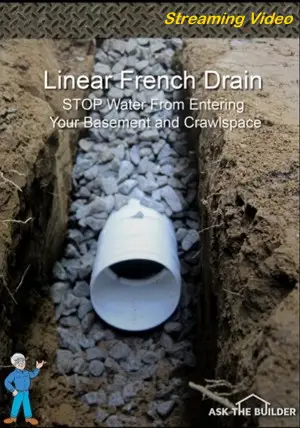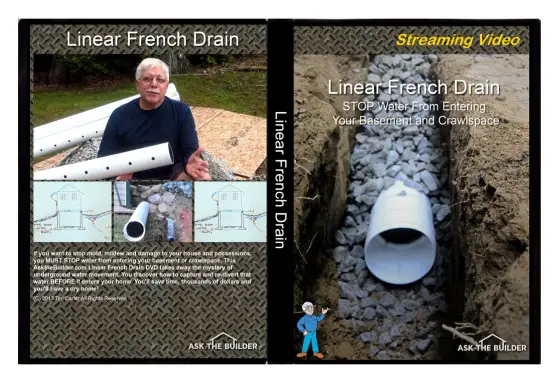Crawlspace Waterproofing

You can see standing water next to the house on the right. Lots of water flows down the grassy area from the top of the hill. Photo Credit: Mike Hardy
Quick Column Summary:
- Problem with water entering crawlspace
- A crawlspace below grade is similar to a pond
- Waterproof your basement by diverting the water
DEAR TIM: I've got a chronic problem with water entering the 4-foot-tall crawlspace under the duplex I live in. This year has been bad with all the rain we're having. We installed a swale, but that has not helped. I know the ground water is causing the problem, but I'm at my wits end how to solve it. Is there a magic silver-bullet solution that will keep the water out of the crawlspace? Mike H., Marysville, MO
DEAR MIKE: Hundreds of thousands, perhaps millions, of homeowners suffer from chronic water seepage into crawlspaces and basements. Areas that have clay-rich soil seem to be the ones that have the greatest problems. I've helped tens of thousands of people dry out their crawlspaces and basements using simple knowledge I obtained getting my geology degree back in college.
It helps to understand what's going on below the surface of the ground if you want to solve water problems in crawlspaces and basements. Think about how ponds are constructed where you live and what's going on so the water stays in the pond and doesn't drain away or soak into the ground overnight.
A basement or crawlspace that's below grade is not much different than a shallow pond. It's a hole in the ground that will naturally fill with water because the bottom of the crawlspace or basement is lower than all the edges of the hole.
Ponds stay filled with water as long as it rains because the soil at the bottom and slopped sides of the pond contains lots of clay that doesn't allow water to pass through it. That's why clay is used to make pottery as it does a great job of containing liquids.
As you dig into ground, the soil profile normally changes. Top soil near the surface contains lots of organic debris and air. The deeper you dig, the denser the soil gets and there's very little air.
If you have some dry top soil you'll notice rainwater or water from a hose disappears when broadcast on the dry soil. This water starts to fill the air voids and then under the influence of gravity it starts to move downslope below the surface. Most people think that the water in soil moves straight down, but when it hits the denser clay subsoils, it typically moves parallel to the surface of the ground until it seeps out of the soil. Many call these locations springs.
You can waterproof your crawlspace and/or basement forever if you capture and divert this moving underground water before it gets to your house. Once captured, you pipe the water away from the house and allow it to continue on its journey to the ocean or sea.
I've discovered the best way to capture this underground water is to dig a trench that's about 6 inches wide by 2 feet deep. This trench should be about 4 to 6 feet from your foundation wall and surround the house on at least three sides like the letter U. You can make the trench completely surround the house like a moat protects a castle if you desire.
If you want guaranteed results, you want the bottom of this trench to be below the level of your crawlspace or basement floor. This can be problematic for deeper basements. Realize I've stopped the water from entering many, many basements with a trench drain that's just 2 feet deep in clay-rich soils.
For the system to work, there must be a low spot on your land that's lower than the bottom of the trench. Most lots have this kind of fall. What you think is a level lot often has quite a bit of fall to it in 50 or 100 feet of horizontal run. One leg of the trench extends from the house to this low spot on your land.
You install a perforated 4-inch diameter drain pipe in the trench on top of about 2 inches of rounded gravel the size of walnuts. The entire trench is filled with this gravel once the pipe is in place. The gravel must not have any sand or smaller pieces of gravel in it. You want all the pieces to be about the size of a walnut. Water readily flows through gravel like this. Water in the soil wants to find the path of least resistance and this trench is that place.
If you make the bottom of the trench level and the ground in your yard is sloping downhill, eventually the bottom of the trench will emerge from the ground.
When it rains and water is flowing through the soil towards your crawlspace here's what happens. The water is pushing it's way through the top soil and comes to the gravel. It's easier for the water to flow through the gravel than the soil so it goes down to the bottom of the trench and starts to flow in the gravel and into the pipe if there's a heavy volume of water.
Since the trench is level, the water in the trench exits the ground at the low spot on your lot and flows further down towards the next house. Your crawlspace stays dry because the trench acts like the hole in the bottom of your kitchen sink. As long as your kitchen sink drain line is not clogged, water flows out of the sink and into the drain pipe. Your sink remains dry.
The gravel-filled trench drain is simply a huge drain system that is always working, it relies on gravity and it's very, very effective if you have enough fall on your land!
Column 1062
Want a step-by-step procedure on installing a Linear French Drain? Tim's Linear French Drain Video Series Streaming Video shows you how to keep your basement and crawl spaces dry. CLICK HERE or on the image below to order Tim's Streaming Video.


3 Responses to Crawlspace Waterproofing